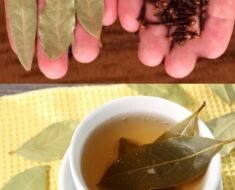Wood sorrel (Oxalis acetosella), affectionately known as cuckoo’s bread, cuckoo’s meat, or Alleluia, is gaining newfound attention. Once dismissed as a simple weed, this extraordinary plant is now celebrated for its impressive health benefits and versatile culinary uses. In this article, we explore the characteristics, advantages, and applications of wood sorrel, along with a delightful recipe to help you incorporate it into your meals.
Characteristics of Wood Sorrel
Leaves:
- Shape and Arrangement: The leaves of wood sorrel are trifoliate, featuring three heart-shaped leaflets that closely resemble those of clover.
- Taste: The leaves possess a unique sour flavor due to the presence of oxalic acid, offering a tangy and refreshing taste.
Flowers:
- Appearance: Wood sorrel flowers are often white or pink, featuring delicate veins that may appear red or violet.
- Bloom Time: These charming blooms typically appear in spring and early summer, adding a touch of elegance to the forest floor.
Identification Tips:
- Growth Pattern: Wood sorrel generally grows in small clusters or mats, creating a lush, green carpet.
- Leaf Color: The leaves are a vibrant green, sometimes exhibiting reddish or purplish tones.
- Flower Characteristics: To identify wood sorrel, look for its small, delicate flowers, each with four petals—this distinctive feature can help you recognize the plant easily.
Benefits of Wood Sorrel
Nutritional Powerhouse:
- Vitamin C: Wood sorrel is a great source of vitamin C, which is vital for maintaining a robust immune system and promoting healthy skin.
- Omega-3 Fatty Acids: This plant is an excellent source of plant-based Omega-3 fatty acids, important for supporting brain and heart health.
- Antioxidants: Wood sorrel contains antioxidants like glutathione, which play a crucial role in protecting the body against oxidative stress and damage from free radicals.
- Minerals: It also provides essential minerals such as calcium, magnesium, potassium, iron, and manganese, all of which support various bodily functions.
Health Benefits
- Digestive Aid: Wood sorrel has been traditionally used to support digestion and alleviate indigestion.
- Anti-Inflammatory Properties: This plant possesses anti-inflammatory qualities that can help reduce inflammation and soothe minor skin irritations when applied topically.
- Natural Detoxification: With its diuretic properties, wood sorrel supports kidney function and promotes overall detoxification.

Culinary Uses
The tangy, lemony flavor of wood sorrel makes it a versatile ingredient in various dishes. Here are some ways to incorporate it into your meals:
Fresh Culinary Creations:
- Salads: Toss fresh wood sorrel leaves into salads for a delightful burst of tanginess. They complement milder greens beautifully, adding a refreshing touch.
- Garnishes: Use wood sorrel as a garnish for soups, roasted vegetables, or grilled meats to enhance both flavor and presentation.
Recipe: Wood Sorrel and Basil Pesto
Ingredients
- 2 cups young wood sorrel leaves and stems, rinsed and coarsely chopped
- 45 grams fresh basil leaves, rinsed
- 1 clove garlic
- 45 grams toasted almonds (or pine nuts)
- Juice of half a lemon
- 50 ml olive oil
- Salt and pepper, to taste
Instructions
- Prepare Ingredients: Rinse the wood sorrel and basil leaves thoroughly. Coarsely chop the wood sorrel and set it aside.
- Blend Ingredients: In a food processor, combine the wood sorrel, basil, garlic, and toasted almonds. Pulse the mixture until finely chopped.
- Add Lemon and Olive Oil: Pour in the lemon juice and olive oil, then blend until the pesto achieves a smooth consistency.
- Season to Taste: Add salt and pepper to suit your preferences. Blend briefly again to incorporate the seasonings.
- Serve or Store: Transfer the pesto to a jar and store it in the refrigerator. It can be enjoyed immediately or kept for up to a week.
Serving Suggestions: This wood sorrel and basil pesto is delightful as a pasta sauce, spread on sandwiches, or as a dip for fresh vegetables.

Wood Sorrel and Berry Smoothie Recipe
Ingredients:
- 1 cup fresh wood sorrel leaves
- 1 cup mixed berries (strawberries, blueberries, raspberries)
- 1 banana
- 1 cup almond milk (or any milk you prefer)
- 1 tablespoon honey or maple syrup (optional)
Instructions:
- Prepare the Ingredients: Thoroughly rinse the wood sorrel leaves and mixed berries. Peel the banana.
- Blend: In a blender, combine the wood sorrel, mixed berries, banana, and almond milk. Blend until the mixture is smooth.
- Sweeten (Optional): If you like it sweeter, add honey or maple syrup and blend briefly to combine.
- Serve: Pour the smoothie into a glass and enjoy immediately for optimal taste and nutrition.
Precautions and Considerations
While wood sorrel offers numerous nutritional benefits, it’s essential to consume it in moderation due to its oxalate content. High levels of oxalates can potentially lead to kidney stone formation in susceptible individuals. If you have any underlying health conditions or concerns, it’s advisable to consult with a healthcare provider before adding wood sorrel to your diet.
Conclusion
Wood sorrel is not just a charming addition to your garden; it’s a nutritional powerhouse with various health benefits. Whether you enjoy it fresh in salads, create a delicious pesto, or blend it into a refreshing smoothie, this versatile herb can enhance your culinary experiences and contribute to your overall well-being. Embrace the resurgence of wood sorrel and discover its incredible potential in your meals and health routine—just remember to enjoy it in moderation due to its oxalic acid content.






